INSTITUT SUPERIEUR D'ANTHROPOLOGIE
INSTITUTE OF ANTHROPOLOGY
ONLINE COURSES / COURS A DISTANCE
SPRING TERM : APRIL 2014
REGISTER NOW
ROYAUME UNI – 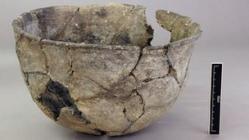 Didcot - A dig ahead of the development of the Great Western Park estate in Didcot, Oxfordshire, discovered humans had lived on the site for 9,000 years. The Didcot Dogmile group said Taylor Wimpey's planned road would cut across the rare pond barrow. Founder Karen Waggott said the Eastern link road would run too close to the Bronze Age pond barrow - one of only about 100 identified in the UK - and a nearby settlement.She said: "The sites [of finds] should be preserved and landscaped to show the size, locations and details of the archaeology, all linked with information boards through the new estate."It would tell such an incredible story of human development from a few prehistoric flint hunting implements 9,000 years ago, through to the first farmers and their ancient rituals, lives and homes, to villas and treasure in Roman times.Timeline of finds at the site: *Mesolithic - 10,000 to 4,000 BC: Flint implements from hunter-gatherers *Neolithic - 4,000 to 2,000 BC: Ceramic bowl (early) *Bronze Age - 2,000 to 800 BC: Pond barrow used for mortuary ceremonies (early), three roundhouses within ditched enclosure around pond barrow (later) * Iron Age - 800 BC to 43 AD: Large settlement with up to 60 roundhouses, animal enclosures, trackway, grain storage pits also used for human burials * Roman - 43 to 410 AD: Hoard of 400 coins, Roman villa with bathhouse, human burials, corn drying ovens.
Didcot - A dig ahead of the development of the Great Western Park estate in Didcot, Oxfordshire, discovered humans had lived on the site for 9,000 years. The Didcot Dogmile group said Taylor Wimpey's planned road would cut across the rare pond barrow. Founder Karen Waggott said the Eastern link road would run too close to the Bronze Age pond barrow - one of only about 100 identified in the UK - and a nearby settlement.She said: "The sites [of finds] should be preserved and landscaped to show the size, locations and details of the archaeology, all linked with information boards through the new estate."It would tell such an incredible story of human development from a few prehistoric flint hunting implements 9,000 years ago, through to the first farmers and their ancient rituals, lives and homes, to villas and treasure in Roman times.Timeline of finds at the site: *Mesolithic - 10,000 to 4,000 BC: Flint implements from hunter-gatherers *Neolithic - 4,000 to 2,000 BC: Ceramic bowl (early) *Bronze Age - 2,000 to 800 BC: Pond barrow used for mortuary ceremonies (early), three roundhouses within ditched enclosure around pond barrow (later) * Iron Age - 800 BC to 43 AD: Large settlement with up to 60 roundhouses, animal enclosures, trackway, grain storage pits also used for human burials * Roman - 43 to 410 AD: Hoard of 400 coins, Roman villa with bathhouse, human burials, corn drying ovens.
http://www.bbc.co.uk/news/uk-england-oxfordshire-25747212
NEPAL - Bhawanipur / Jitgadi - The Department of Archaeology has started excavation at the historically and archaeologically important sites of Jitgadi and Bhawanipur in Rupandehi with a view to finding facts related to Lord Buddha.::According to the department’s officer Prakash Darnal, preparations for excavation at Bhawanipur and Jitgadi fort, which lie in Kerawani VDC and Butwal municipality respectively, started yesterday. The excavation aims to identify the birth place of Mayadevi, Buddha’s mother, surrogate mother Prajapati, and his wife Yashodhara, and at the same time to confirm the capital of Koliya state where Buddha’s maternal house is said to be located. This is the third excavation in Bhawanipur after excavations in 2011 and 2012 , when statuettes of Surya, Ganesh, and Shivalingas and other archaeologically important artifacts were discovered. The excavation will continue for 20 days. So far, Bhawanipur of Kerawani, and Kanyamai and Bairimai areas of Devdaha are accepted as Lord Buddha’s maternal place, but it is yet to be proved by archaeological findings. Likewise, excavation at Panditpur in Banjariya VDC in Nawalparasi will also resume in some days. For excavation in Jitgadi, the concerned department has outlined the areas to be excavated. The actual excavation will start from tomorrow. Though the entrance to a long tunnel had been explored in Jitgadi about 18 years ago, the department had not carried out any excavation work due to lack of budget.
http://www.thehimalayantimes.com/fullNews.php?headline=Excavation+starts+at+Bhawanipur+and+Jitgadi&NewsID=403794
TURQUIE - 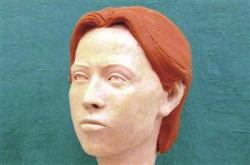 Marmaray - The face of a 1,000-year-old skeleton, which was unearthed during the Marmaray project excavations in Istanbul’s Yenikapı, was restructured by the Yıldız Technical University Istanbul Historic Peninsula Application and Research Center Biological Material Inspection Commission. The skeleton was named Maria by the commission president Mehmet Görgülü because it was the most popular name in that era. This ancient lady is estimated to have been 30 years old when she died, had red hair and was a member of one of the noble Byzantium families. Görgülü, who is a general surgery and medical sciences specialist, said the skeletal pieces unearthed in the excavations were not only observed archaeologically, but they were analyzing deformations in the bones to understand diseases, genetic relativity and causes of people’s death. When all of these examinations are completed, he said, he plans on writing a book on all of the details of Yenikapı.
Marmaray - The face of a 1,000-year-old skeleton, which was unearthed during the Marmaray project excavations in Istanbul’s Yenikapı, was restructured by the Yıldız Technical University Istanbul Historic Peninsula Application and Research Center Biological Material Inspection Commission. The skeleton was named Maria by the commission president Mehmet Görgülü because it was the most popular name in that era. This ancient lady is estimated to have been 30 years old when she died, had red hair and was a member of one of the noble Byzantium families. Görgülü, who is a general surgery and medical sciences specialist, said the skeletal pieces unearthed in the excavations were not only observed archaeologically, but they were analyzing deformations in the bones to understand diseases, genetic relativity and causes of people’s death. When all of these examinations are completed, he said, he plans on writing a book on all of the details of Yenikapı.
http://www.hurriyetdailynews.com/byzantine-ladys-face-revealed-given-name-of-maria.aspx?pageID=238&nID=61400&NewsCatID=375
PEROU – 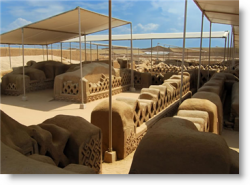 Chan Chan - Work has been completed to protect the pre-Inca adobe city of Chan Chan from heavy seasonal rains, in northern Peru. The adobe structures of Chan Chan, located just outside of the coastal city of Trujillo, have been damaged in the past when heavy rains were brought on by a warm El Niño ocean current. Although the Ocean Institute (Imarpe) doubts there will be an El Niño this year, even mild showers could damage some of the intricately carved walls at the site. The project involved cleaning out drainage systems and maintaining coverings of the adobe walls. Chan Chan, a 28-square-mile city, was added to UNESCO’s World Heritage Site list in 1986. It was the capital of the Chimu kingdom, which ruled Peru’s northern coast from about 900 AD until it was conquered by Inca armies in the late 15th century during the rule of Tupac Inca Yupanqui. During its peak, Chan Chan was the largest pre-Columbian city in the Americas and the biggest adobe city in the world.
Chan Chan - Work has been completed to protect the pre-Inca adobe city of Chan Chan from heavy seasonal rains, in northern Peru. The adobe structures of Chan Chan, located just outside of the coastal city of Trujillo, have been damaged in the past when heavy rains were brought on by a warm El Niño ocean current. Although the Ocean Institute (Imarpe) doubts there will be an El Niño this year, even mild showers could damage some of the intricately carved walls at the site. The project involved cleaning out drainage systems and maintaining coverings of the adobe walls. Chan Chan, a 28-square-mile city, was added to UNESCO’s World Heritage Site list in 1986. It was the capital of the Chimu kingdom, which ruled Peru’s northern coast from about 900 AD until it was conquered by Inca armies in the late 15th century during the rule of Tupac Inca Yupanqui. During its peak, Chan Chan was the largest pre-Columbian city in the Americas and the biggest adobe city in the world.
http://www.peruviantimes.com/21/culture-ministry-completes-work-to-protect-chan-chan-from-rains/21268/
JAPON - 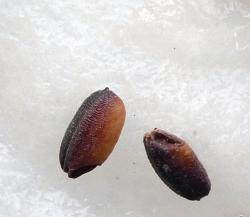 Akitsu - Eleven grains of brown rice believed to date back to the early Yayoi period, around 2,600 to 2,400 years ago, were found at the location of a former paddy in the Akitsu archaeological site in Goze, Nara Prefecture. Due to the well-preserved condition of the grains, they were expected to provide clues about the rice cultivated by ancient people of the period, according to experts. Kyoto University Prof. Tatsuya Inamura, an expert on plant production systems, revealed the discovery at a research meeting of Nara Prefecture’s Archaeological Institute of Kashihara on Jan. 12 The rice grains, which were first excavated in November, were brown and about four millimeters in length. The rice did not have husks. The grains are believed to have been so well-preserved because they were sealed in mud with high water content and were not exposed to air. It is rare to discover rice from the Yayoi period that has not undergone carbonization, according to Inamura. Inamura intends to work in cooperation with the institute, using DNA analysis and radiocarbon dating to identify the ancient rice’s variety and gather other information.
Akitsu - Eleven grains of brown rice believed to date back to the early Yayoi period, around 2,600 to 2,400 years ago, were found at the location of a former paddy in the Akitsu archaeological site in Goze, Nara Prefecture. Due to the well-preserved condition of the grains, they were expected to provide clues about the rice cultivated by ancient people of the period, according to experts. Kyoto University Prof. Tatsuya Inamura, an expert on plant production systems, revealed the discovery at a research meeting of Nara Prefecture’s Archaeological Institute of Kashihara on Jan. 12 The rice grains, which were first excavated in November, were brown and about four millimeters in length. The rice did not have husks. The grains are believed to have been so well-preserved because they were sealed in mud with high water content and were not exposed to air. It is rare to discover rice from the Yayoi period that has not undergone carbonization, according to Inamura. Inamura intends to work in cooperation with the institute, using DNA analysis and radiocarbon dating to identify the ancient rice’s variety and gather other information.
http://www.the-japan-news.com/news/article/0000957239
EGYPYE – 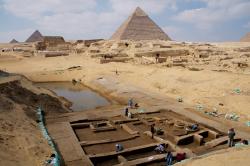 Gizeh - A basin that was likely part of an ancient harbour, a building complex connected to ancient royal cult and other new finds shed more light to the character of the Giza Plateau. According to Live Science, archaeologists working at the Giza Pyramids have revealed a number of more or less impressive architectural elements which help us to define yet unknown elements of what Giza Plateau might have represented during Antiquity. Among them is a basin, which was found full of groundwater and is located about 0.6 miles (1 km) from the nearest channel of the Nile River. According to Mark Lehner, the director of Ancient Egypt Research Associates, the basin may be an extension of a harbor or waterfrontthat might had kept Giza supplied with goods, including wood from the eastern Mediterranean and granite from Aswan on Egypt’s southern border. A corridor running to the north of the basin connects the harbor with a town to the west and a newly excavated building-complex to the east, just 400 meters (1,312 feet) south of the Sphinx. Archaeologists uncovered a house and nearby mound containing the hind limbs of young cattle alongside the seals of high-ranking officials and leopard teeth (but no leopard). The house, containing at least 21 rooms, dates mainly to the time when the pyramid of Menkaure (the last of the Giza Pyramids) was being built. The officials’ administrative titles ( “the scribe of the royal box” and “the scribe of the royal school,”) connected with the leopard teeth (likely coming from the head of leopard skins -a usual attire for a certain category of priests connected to royal cult) and the bones sugges that the complex was occupied by royal cult priests. Dubbed “the silo-building complex”, the building included grain silos and bakeries. This royal cult performance was probably in the name of pharaoh Khafre, whose name survives on a seal found on the site. The archaeologists have also been excavating a series of long, 23-feet high (7 meters), structures now called the “galleries”, likely used to hold troops performing guard duties for important people while at Giza. The finding of charcoal remains of cedar (a wood from abroad) in the interior, suggests that soldier inhabitants of the galleries can be linked to the eastern Mediterranean.
Gizeh - A basin that was likely part of an ancient harbour, a building complex connected to ancient royal cult and other new finds shed more light to the character of the Giza Plateau. According to Live Science, archaeologists working at the Giza Pyramids have revealed a number of more or less impressive architectural elements which help us to define yet unknown elements of what Giza Plateau might have represented during Antiquity. Among them is a basin, which was found full of groundwater and is located about 0.6 miles (1 km) from the nearest channel of the Nile River. According to Mark Lehner, the director of Ancient Egypt Research Associates, the basin may be an extension of a harbor or waterfrontthat might had kept Giza supplied with goods, including wood from the eastern Mediterranean and granite from Aswan on Egypt’s southern border. A corridor running to the north of the basin connects the harbor with a town to the west and a newly excavated building-complex to the east, just 400 meters (1,312 feet) south of the Sphinx. Archaeologists uncovered a house and nearby mound containing the hind limbs of young cattle alongside the seals of high-ranking officials and leopard teeth (but no leopard). The house, containing at least 21 rooms, dates mainly to the time when the pyramid of Menkaure (the last of the Giza Pyramids) was being built. The officials’ administrative titles ( “the scribe of the royal box” and “the scribe of the royal school,”) connected with the leopard teeth (likely coming from the head of leopard skins -a usual attire for a certain category of priests connected to royal cult) and the bones sugges that the complex was occupied by royal cult priests. Dubbed “the silo-building complex”, the building included grain silos and bakeries. This royal cult performance was probably in the name of pharaoh Khafre, whose name survives on a seal found on the site. The archaeologists have also been excavating a series of long, 23-feet high (7 meters), structures now called the “galleries”, likely used to hold troops performing guard duties for important people while at Giza. The finding of charcoal remains of cedar (a wood from abroad) in the interior, suggests that soldier inhabitants of the galleries can be linked to the eastern Mediterranean.
http://www.archaiologia.gr/en/blog/2014/01/22/new-light-at-the-giza-plateau/
USA – Miami - A set of Indian artifacts are set to be unveiled in Miami Lakes this afternoon. The artifacts were originally excavated from the Madden’s Hammock archaeological site in Miami Lakes but have been at at the University of Florida. Eighteen artifacts will be unveiled including clay, a necklace, a bowl, and an alligator tooth.
http://miami.cbslocal.com/2014/01/22/miami-lakes-to-unveil-indian-artifacts/
ITALIE- 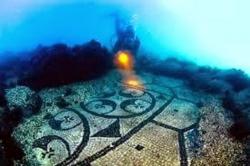 Baiae - Heavy flooding south of Naples have caused landslips that exposed Roman walls at Baiae, an ancient Roman fleshpot resort near Pompeii attracting the empire's great and good, archaeologists said Wednesday. Baiae - modern Baia, near Sophia Loren's birthplace Pozzuoli - was a fashionable getaway for several hundred years, especially towards the end of the Roman Republic. Even more popular than Pompeii, Herculaneum, and Capri with the super-rich, it was notorious for the hedonistic temptations on offer, and for rumours of scandal and corruption. The famously decadent emperor Caligula (ruled 37-41 AD) staged a spectacular stunt at the ancient site of Pozzuoli, Puteoli, soon after his coronation, riding across a two-mile pontoon bridge in defiance of an astrologer's prediction that he had "no more chance of becoming emperor than of riding a horse across the Gulf of Baiae". Baiae was an integral part of Portus Julius, home port of the western Imperial Fleet of ancient Rome. The town was sacked by Saracen raiders in the 8th century AD and was deserted because of malaria by 1500. Because of coastal subsidence most of Baiae is now under water in the Bay of Naples, largely due to local volcanic activity. Exquisite statues and rich mosaics are magnets for divers.
Baiae - Heavy flooding south of Naples have caused landslips that exposed Roman walls at Baiae, an ancient Roman fleshpot resort near Pompeii attracting the empire's great and good, archaeologists said Wednesday. Baiae - modern Baia, near Sophia Loren's birthplace Pozzuoli - was a fashionable getaway for several hundred years, especially towards the end of the Roman Republic. Even more popular than Pompeii, Herculaneum, and Capri with the super-rich, it was notorious for the hedonistic temptations on offer, and for rumours of scandal and corruption. The famously decadent emperor Caligula (ruled 37-41 AD) staged a spectacular stunt at the ancient site of Pozzuoli, Puteoli, soon after his coronation, riding across a two-mile pontoon bridge in defiance of an astrologer's prediction that he had "no more chance of becoming emperor than of riding a horse across the Gulf of Baiae". Baiae was an integral part of Portus Julius, home port of the western Imperial Fleet of ancient Rome. The town was sacked by Saracen raiders in the 8th century AD and was deserted because of malaria by 1500. Because of coastal subsidence most of Baiae is now under water in the Bay of Naples, largely due to local volcanic activity. Exquisite statues and rich mosaics are magnets for divers.
http://www.ansa.it/web/notizie/rubriche/english/english.shtml